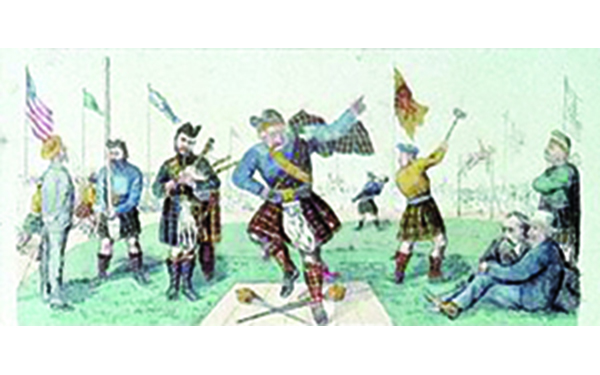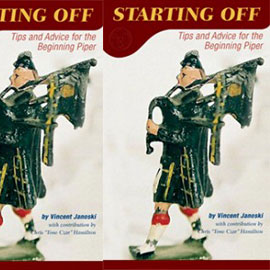5 Things That Shaped U.S. Piping and Drumming This Decade
 Admit it, 2010 is already fading from your memory like The Lost Piobroch. By the time this Saturday hits, your bagpipe competitive successes and failures will be replaced by thoughts of the coming 2011 piping season—new music, travel, delicious meat pies to come. Well, let us remind you that the last decade has not left U.S. piping and drumming unscathed. What has shaped our art through the first full decade of the twenty-first century? Here is a list of five things that shaped, or left an indelible mark on, American piping and drumming in the last ten years.
Admit it, 2010 is already fading from your memory like The Lost Piobroch. By the time this Saturday hits, your bagpipe competitive successes and failures will be replaced by thoughts of the coming 2011 piping season—new music, travel, delicious meat pies to come. Well, let us remind you that the last decade has not left U.S. piping and drumming unscathed. What has shaped our art through the first full decade of the twenty-first century? Here is a list of five things that shaped, or left an indelible mark on, American piping and drumming in the last ten years.
No. 5 — The building of online community.
The earliest days of internet culture saw the rise of community bulletin boards which morphed into newsgroups and mailing lists. The “aughts” saw piping and drumming gravitate to this new medium like moisture on a reed. The audience that grew from the old rec.music.makers.bagpipe and moved to the current forums started by the late Bob Dunsire continues to grow today and the “dunsire forums” and their offshoots are now the default places to find up to the minute gossip, scuttlebutt, results and immediate first-hand accounts of the events that shake the piping world. From there, the communities and fellowship that spring forth onto other media such as Facebook and Twitter remove the old obstacles of geography and distance and make the piping world that much smaller and tighter-knit.
No. 4 — The elimination of the “off season.”
The last decade has seen an explosion of educational offerings and competitive and performance events for pipers and drummers which, to everyone’s benefit, have also become popular gathering points for the piping community. Expanded educational offerings such as Winter Storm in Kansas City, the tried and true “summer schools” offered countrywide, as well as wintertime events such as the U.S. Silver and Gold Medal events at Winter Storm and The Metro Cup in Newark, NJ in February have all but eliminated any downtime pipers and drummers typically went through in the late-fall through spring. The opportunities offered now make it possible for an active competitive soloist or bandsmen to perform, compete, learn, and stay sharper than ever year ’round.
No. 3 — The rise of the organization.
The success of groups such as Field Marshal Montgomery and Simon Fraser University over the last decade have as much to do with the quality of those bands’ organizations as it does with their music. The two go hand in hand. The passing decade revealed that it is no longer possible to excel in the realm of pipe band competition without an effective organizational structure and framework. No longer can a loose collection of players getting together to have fun and play music make any serious gains on the competition field. The logistics of travel, equipment purchase, personnel management, and musical arrangement alone require skills in fundraising and finance, as well as general executive function—all outside the ability to play pipes and drums. The competition game has become a serious one over the last decade and a serious musical attempt by any group requires a serious organization at its foundation.
No. 2 — The viral spread of digital media.
Digital music and video, aided by the medium of the internet, has given access to the events and history of our art like never before. Say what you will about the general legality of any of it, but there can be no doubt that the instant gratification of an emailed sheet of music, or video link, or recorded audio snippet has given more people than ever before access to the best of our art. Whether it is a personal video of your band’s performance at a local games, the prize-winning performance by a Grade 1 band or premier soloist at a high-level event, the archival home videos from the great solo performances of the past, or the BBC-backed “webcasts” of something like the World Pipe Band Championships, pipers and drummers of all levels worldwide can now partake in the experience and bear witness to the performances that inspire us all.
No. 1 — The rise of the synthetic.
The use of synthetic materials in reeds, bags, and drum heads is certainly not unique to the past ten years, but the last decade saw their use creep into a level of innovation and development in piping and drumming products that has likely not been seen—ever. The experimentation in materials in moisture control systems, pipe bags, and drone reeds has given any piper at any level the opportunity to find an instrument set up that is more comfortable and playable than could be created using the old natural traditional materials of cane and hide. As a result, more people than ever before can now take up the bagpipe and reach a personally satisfying level of competency. Newer, more efficient pipe bags and drone reeds have provided an easier learning experience and a more rapid development for beginning musicians. The general age of the latest crop of top North American soloists stands as an example of what can be achieved in a short period of time when the frustrations that were once an impediment to learning have been removed. These materials have given experienced players and bands greater flexibility to find their ideal sound as well. The ready adoption by the players and bands at the top of competitive success have only hastened the adoption of these materials and spread their benefits to the greater piping community. As a result, a general listen at your average games can hear even mid-range soloists sounding pretty darn good. Pipe bands at the lower grades sound better than ever and the sound of higher level bands continues to reach a point of perfection that bands fifteen years ago or earlier only dreamed about.
 Pipehacker
Pipehacker








